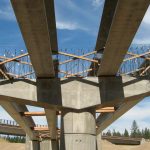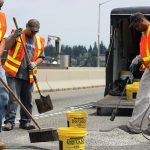Benchmarking and Safety Assessment for Modified Lateral Spreading Design Procedure Using Three-Dimensional Nonlinear Finite Element Analysis
|
Liquefaction-induced lateral spreading is a critical design consideration for many bridges in highly seismic regions of the Pacific Northwest, with broad impacts on safety for the general public. The current design procedures used to estimate liquefaction-induced lateral spreading in bridge-foundation-soil systems are often overly conservative, with the result that the construction of bridges may be more costly than necessary. This project sought to verify the current modified simplified design procedure and to develop a database and benchmarking framework useful for future evaluations. ... Read More about Benchmarking and Safety Assessment for Modified Lateral Spreading Design Procedure Using Three-Dimensional Nonlinear Finite Element Analysis | |










